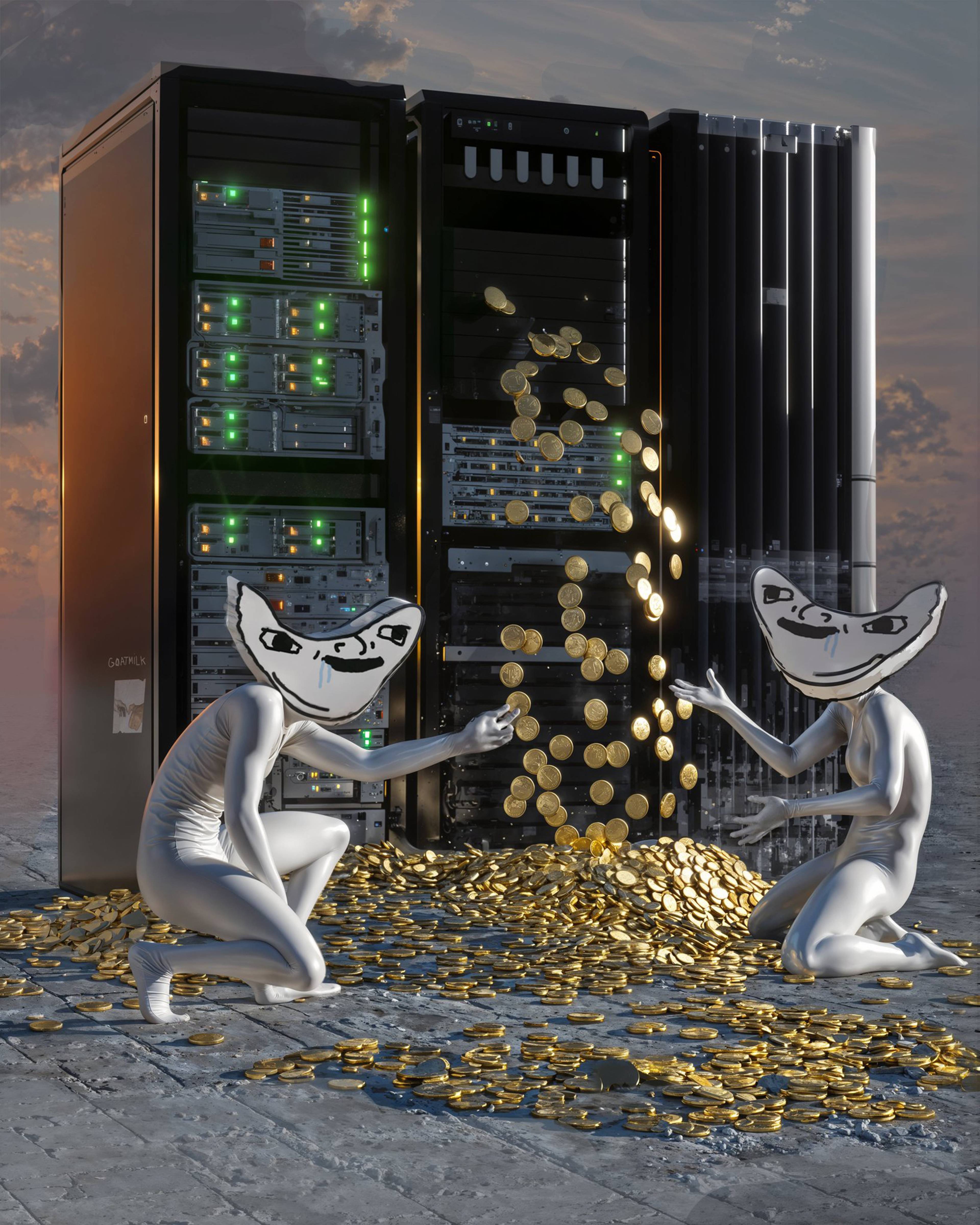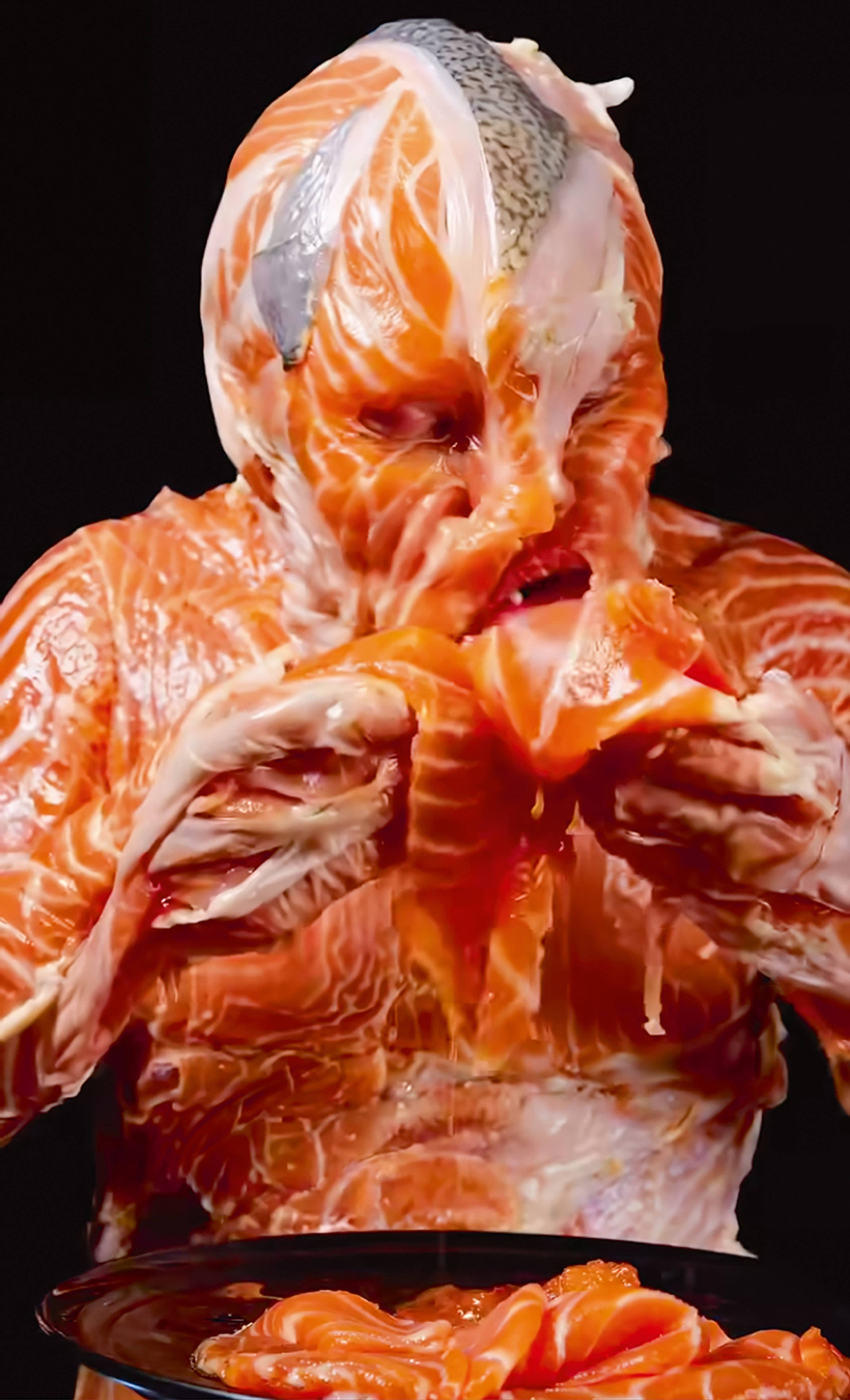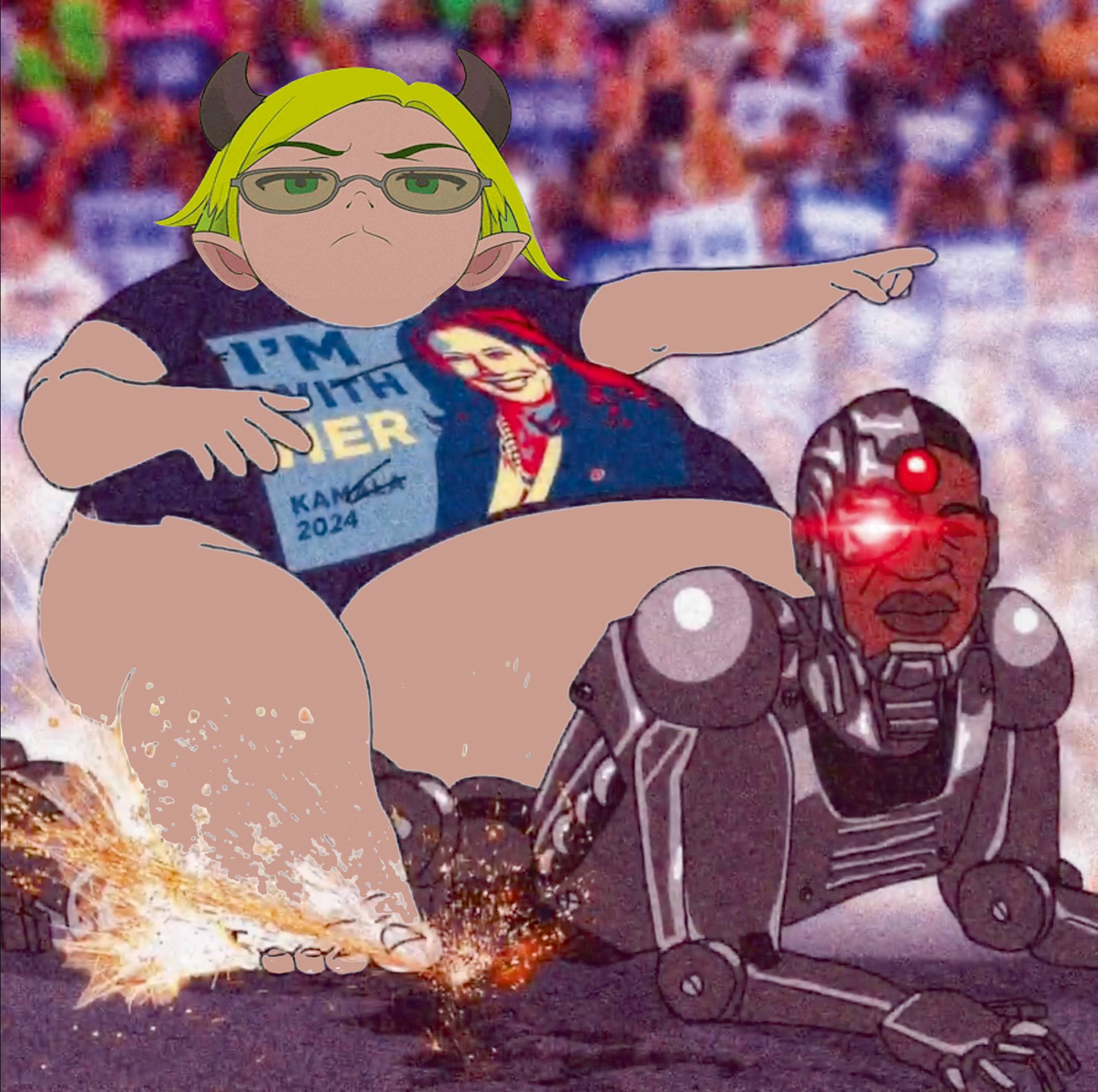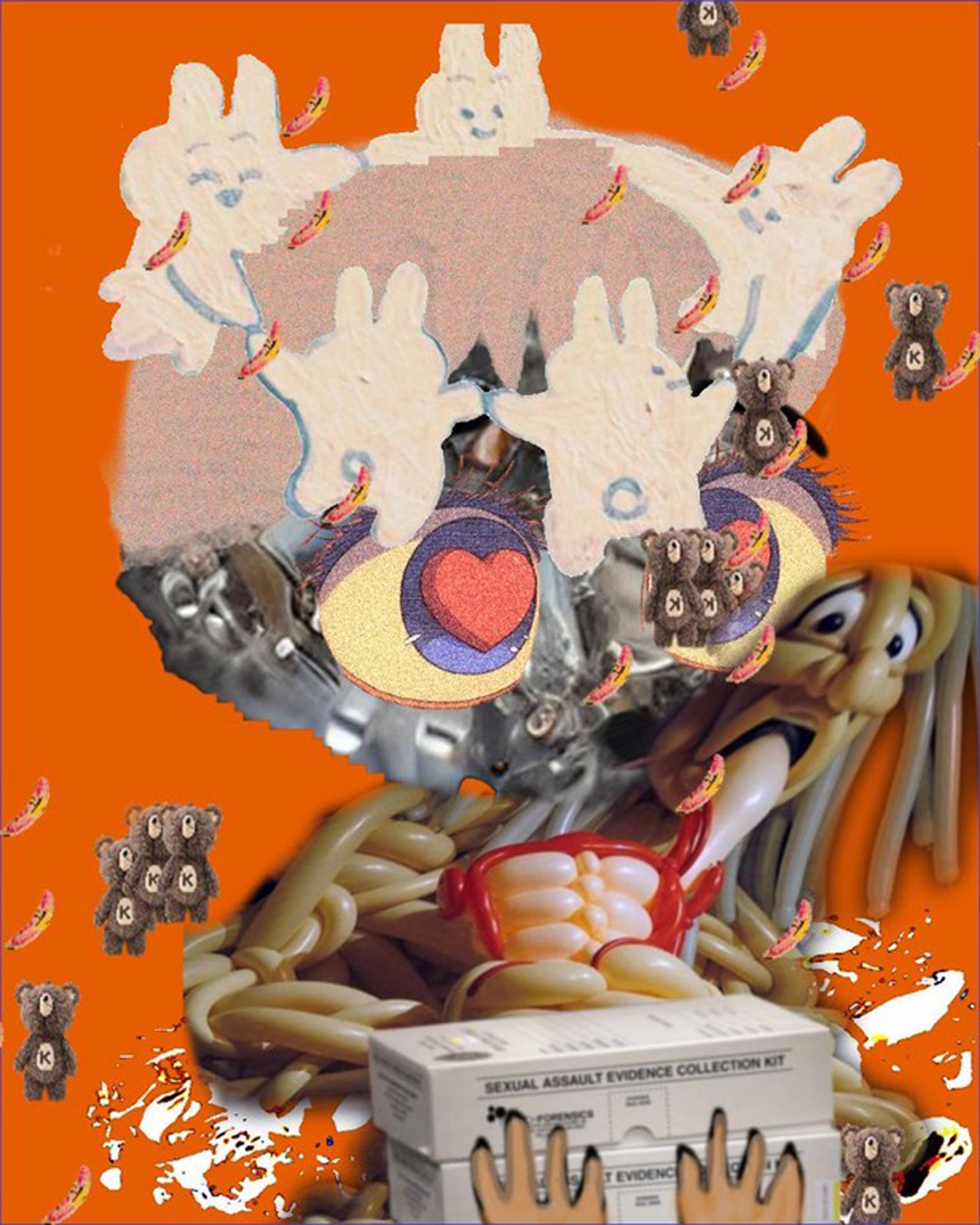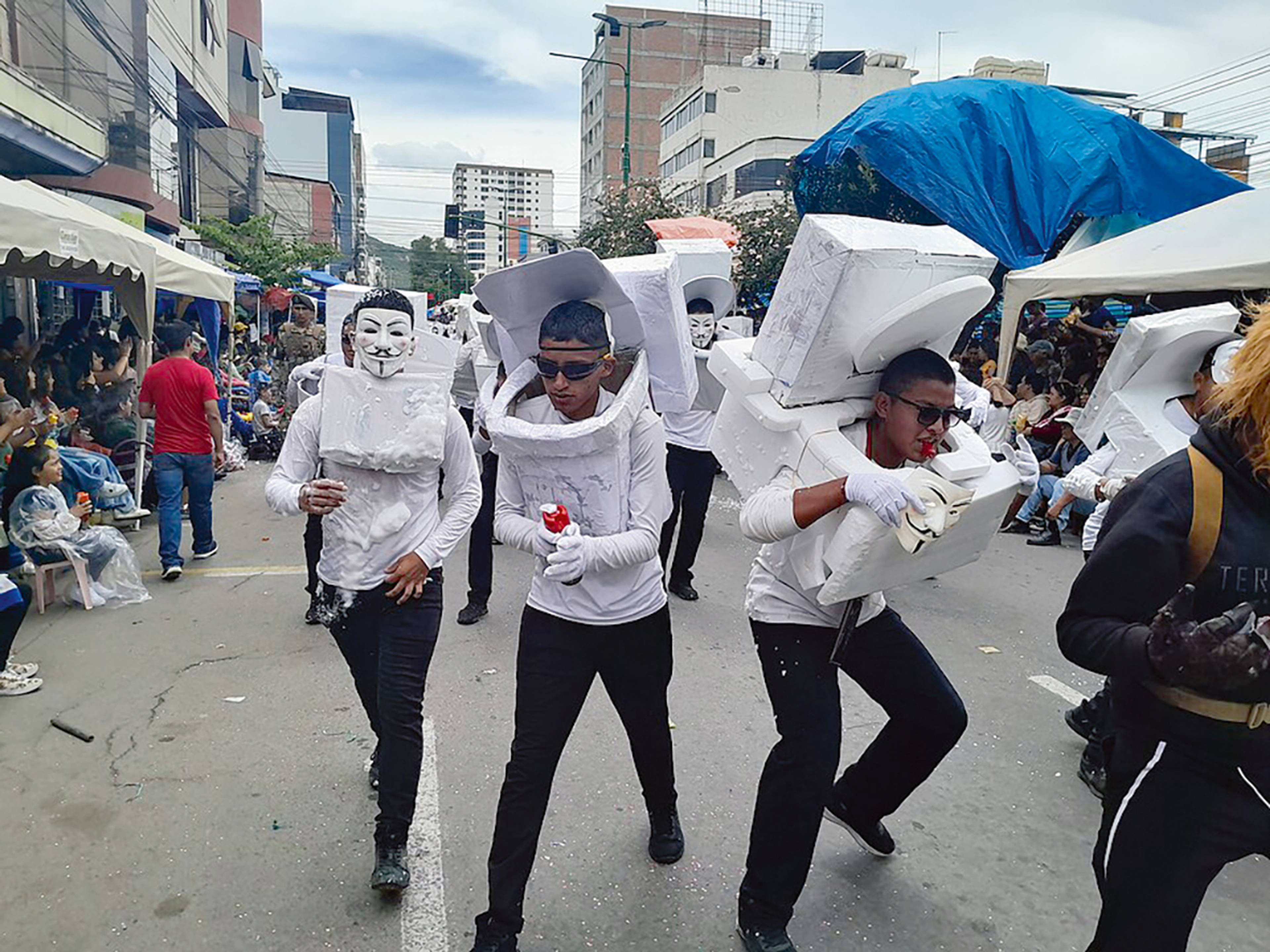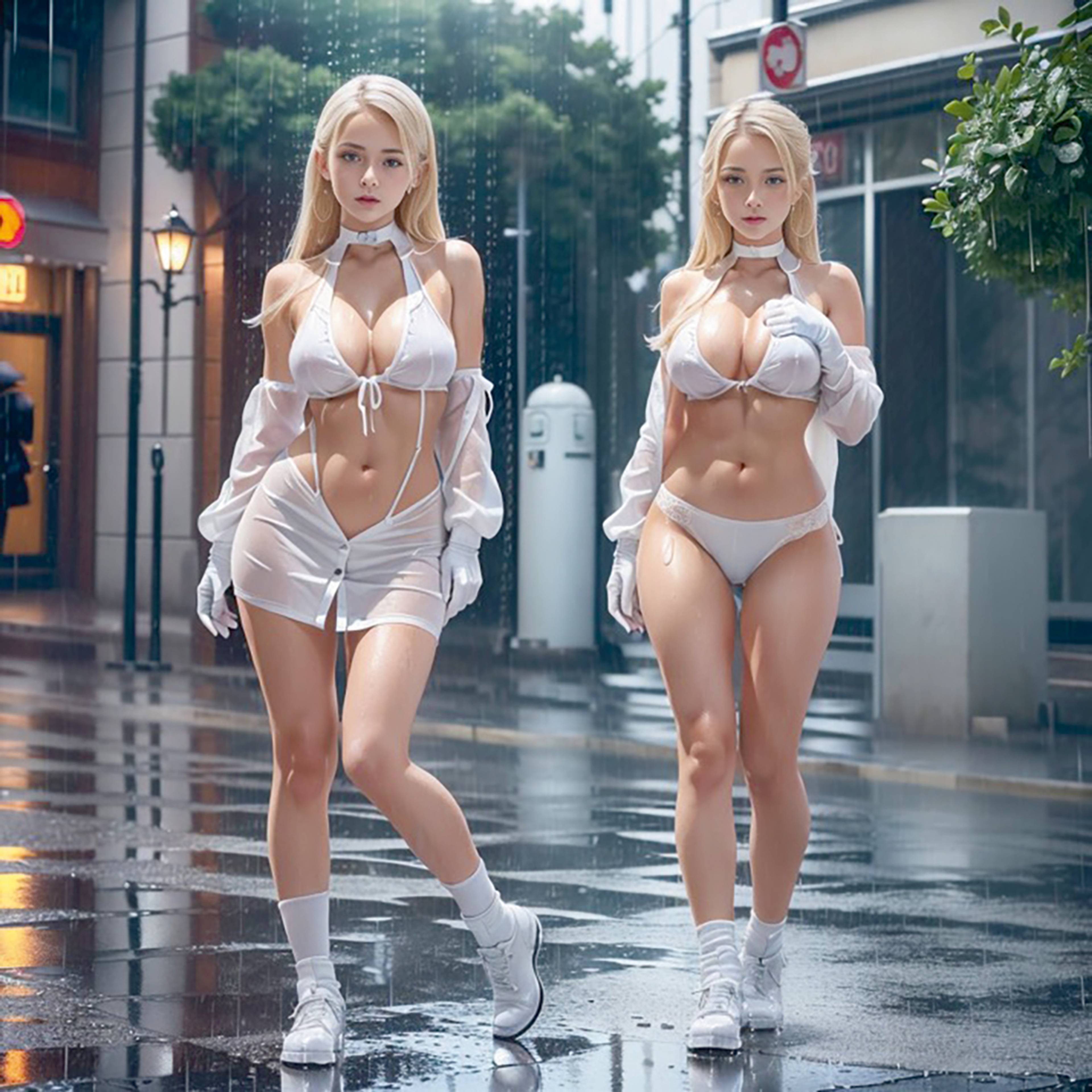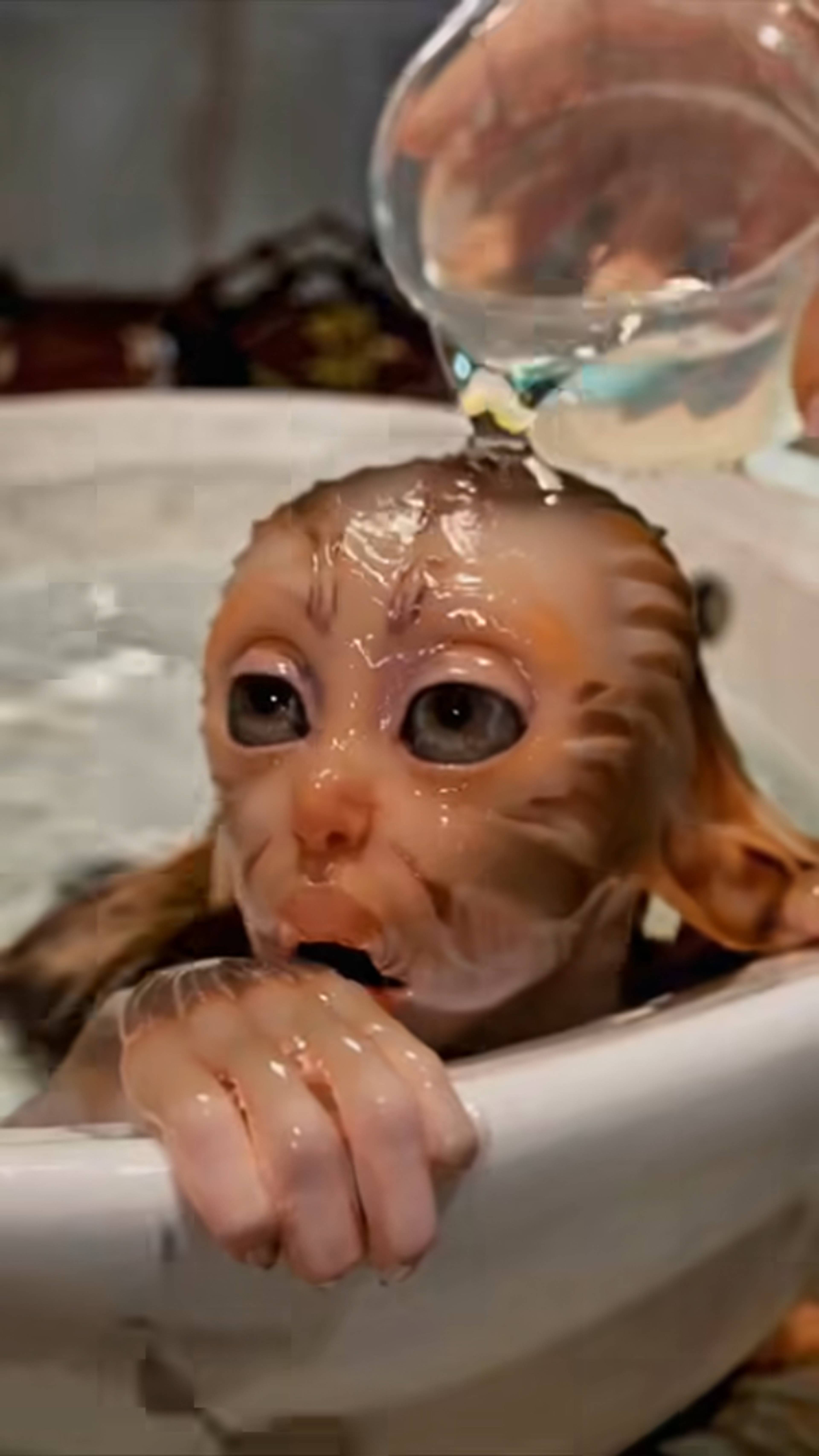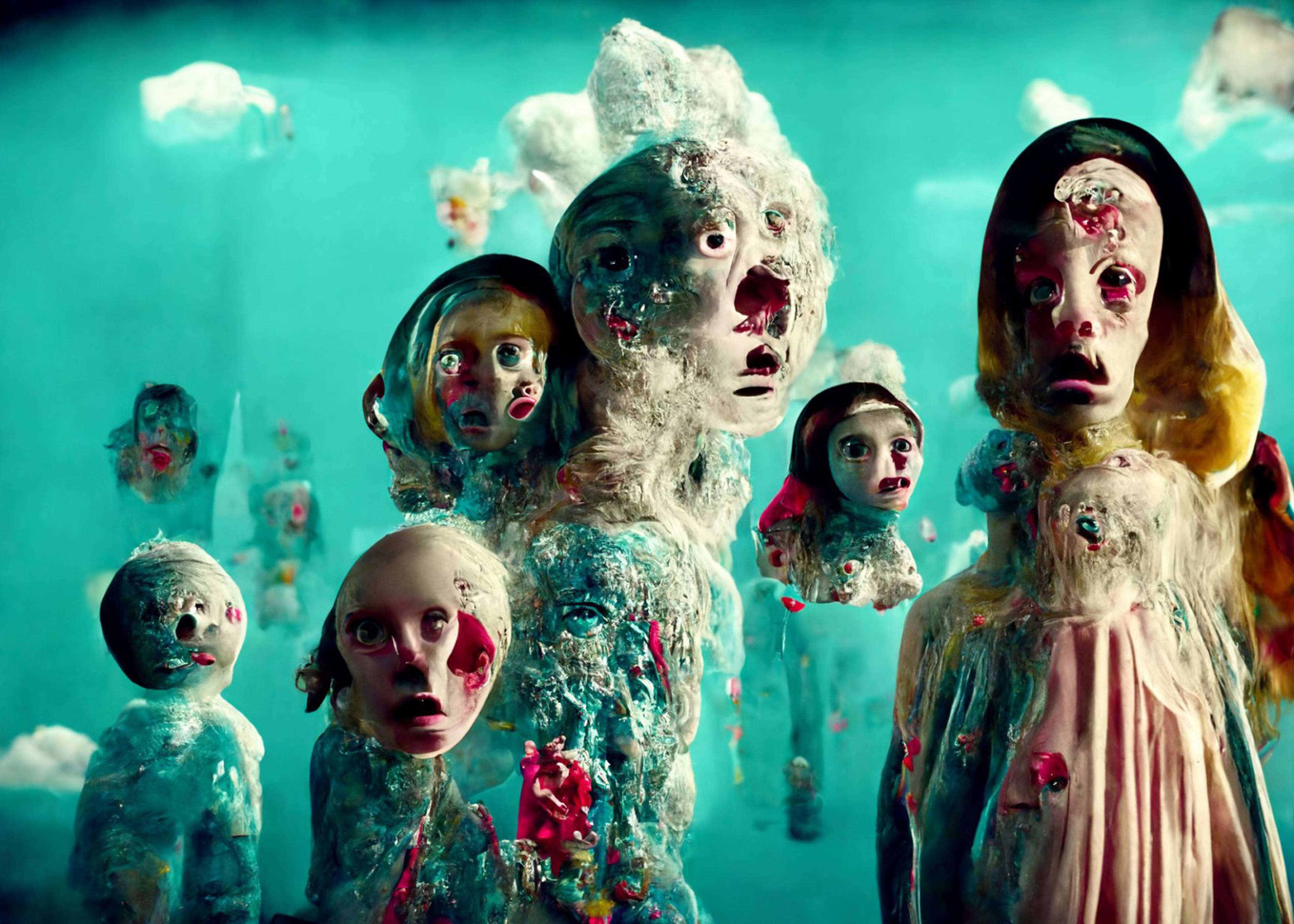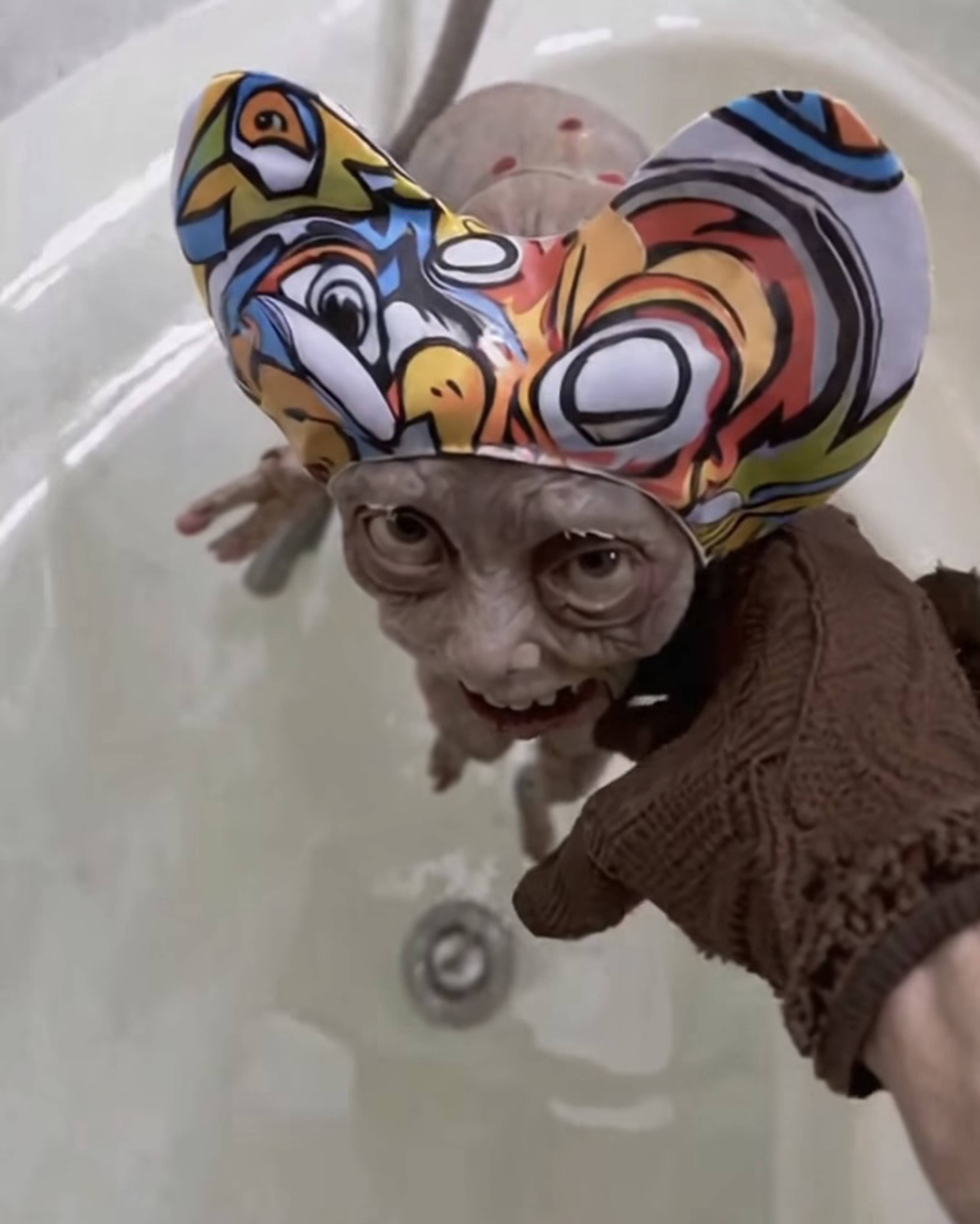— This text was originally published in print in our Summer 2025 issue, Vulgarity—
There is too much beauty in the world. There is too much beauty and there are more beautiful people than there have ever been, and they are generally beautiful in the same way. With trompe l’oeil make-up, fillers, and photo editing, they have given themselves the same face and made same kinds of images of themselves. They are becoming images. They tend toward the same ideal (worked out, contoured, airbrushed, fake) image, they bombard the world with that image relentlessly, every day, and that image continues to infinity. In Soho in London last winter, I had dinner with a beauty editor, a stylist, and a fashion photographer. The photographer, showing us something on her phone, casually observed that her Instagram for you page was full of monsters. That is what she was recommended, videos of monsters. Oh yeah, the very successful beauty editor said, that’s what I have too. They showed me.
Still from a video by Bennett Waisbren (Instagram: @bennettwaisbren)
There are AI-generated monsters stalking Instagram Reels. Hideous ghouls are emerging from real footage of real places: hairless swimming cats with the shrunken heads of elderly Chinese women; the autophagic flayed salmon-man god greedily consuming his own lurid orange flesh; a giddy-eyed, ticklish, mischievous raccoon goblin spirit having his sponge bath. Beauty is boring, so we turn to the grotesque. The Instagram mainstream is transmuted into a 1990s Matthew Barney film. My for you page was once filled with conventionally beautiful girls. That was what Meta’s engineers showed other men whose predilections and desires they had not yet figured out. They had a vague idea of my sexuality and my preferences regarding hair color, body type, and skin tone, but nothing more. These days, it is just full of junk (boys jumping off bridges). But, one night in Berlin this summer, I remembered that I had access to a clean work account that had never been used for anything other than promoting arts events. I went to the explore page; it was crawling with monsters. These creations cannot be found in mythology, but are chimeric beings made in novel combinations of humans, animals, and other things. They take new forms and are a new form of expression. They are different to anything that came before, yet also a continuation of the oldest traditions.
For a while now, I have been collecting images that approach a new aesthetic of the present. One that is undignified, gross, deformed, or otherwise repulsive. In rough chronological order of when they became popular: conspiracy-brain photomontages by former Sesame Street Magazine illustrator David Dees (1957–2020); trollfaces, Pepes, groypers, Wojaks, brainlets, and other stock characters of the stream; deep fake pornography; Beeple’s dank, daily CGI debasements of the satirical newspaper cartoon tradition; Mutant Ape Yacht Club NFTs and other diseased internet streetwear for dudes missing the self-awareness component of the psyche; and, reacting against such multimillion-dollar NFT empires, the subcultural “avant” or “gay NFT” movement of self-consciously esoteric, visually overcomplicated and relatively financially worthless collections, with MiFella’s abject “cuckcore” aesthetic at its heart; those aforementioned kitsch monsters lurking in Instagram and other latent spaces; the Skibidi Toilet series of YouTube Shorts; AI-sculpted 3D models of girls that look like they have tumbled out of a live-action hentai remake; provocation-as-currency meme coins like $N*gga – whose founder, a young white boy named Trevor, shills his cryptocurrency with livestreamed stunts like dressing up in blackface, smoking methamphetamine, crack cocaine, and fentanyl, and knocking out his front teeth, all the while preaching that his coin will “end racism” – and George Droyd, a cyborg version of George Floyd brought back to life with artificial intelligence by Microsoft (both covered elsewhere in this issue); Bianca Censori’s invisible dress at the Grammys; US Vice President JD Vance’s face repeating over many different heads. They are “vulgar” because they are lacking in cultivation or taste, and are not beautiful, but ugly. They are Vulgar Images. They share certain qualities: they are figurative, tasteless, illegible, stupid, fake, disembodied, grotesque, transformed. Some are ludicrously offensive, but it is unlikely that many are that offended by them, as the event horizon of trolling was crossed some while ago. They are also extremely contemporary images.
George Droyd meme
*TASTELESS
There is mutual animosity between the high and low arts. The majority of internet culture is low-brow, populist, and made in knowing or dumb opposition to high art and culture’s aesthetic and moral values. Contemporary art, likewise, no longer has or seeks to have a connection with popular visual culture. While traditional folk and outsider art from around the globe is lately welcomed into and venerated in the contemporary art museums that had for so long excluded it, the folk art of the day – which is internet culture – is rarely represented or spoken of.
The 21st century is afflicted by a tyranny of good taste and deadening refinement culture. There’s far too much good taste: too many white designer logo T-shirts and monogrammed goods, knockoff patterned Goyard handbags, Marc Jacobs tote bags that say “TOTE BAG,” bakeries approaching perfection, never-ending coffee-shop playlists, white-walled gallery shows of very large painted pastiches of modern art. Culture has been cultivated and refined to the point of maddening blandness, and the Vulgar Image is a reaction against such tasteful mediocrity. A popular meme format, the Bell Curve, is bookended by two stock characters: a drooling simpleton on the left, in the low-IQ idiot swamp, and a mega-brained nerd on the right, in the genius zone. Both are in agreement with one another. They discern the truth for very stupid or very clever reasons respectively, unlike all of the reasonably intelligent people in-between that cannot. The Bell Curve signifies contempt for the middle and the ordinary. To thrive in the new world with all its accelerating complexity and overproduction, it suggests, one must either be a genius or a braindead, unthinking moron – and, by the same token, to make the most brilliant and sophisticated artworks, or the dumbest, most off-putting content possible. Bad taste is a way of standing out when there are too many images. It is also a way of changing the trajectory of aesthetics.
*ILLEGIBLE
The Vulgar Image returns to the desire to make tasteless images; these are some of the most tasteless images possible. The “gay NFT” is a sort of “bad painting.” Disaffected art school-educated alternative NFT artists and some autodidacts too are taking up the lineage of Germans like Martin Kippenberger and Albert Oehlen, who, in the 80s, made deliberately “bad painting” in an ironically distanced and knowing fashion, challenging the status quo by making paintings even more dumb and more meaningless than everyone else’s – contemporary NFT artists have succeeded in making images still uglier and less technically accomplished. Series like MiFella (and sequels, prequels, and bootlegs like MiFella 2, MiFella Genesis, CuckFella, DriFella, DriFella 2, DriFella 3, Drilady, and others) are derivatives of Remilia Collective’s much simpler and sweeter Milady Maker collection (itself a pastiche of Japanese chibi [(or, super deformation]) anime and Tokyo street style) and of one another. In our neo-postmodern era in which cultural production is absolutely dominated by pastiche, and signifiers are often completely severed from their referents, this is an accelerating hyperpastiche.
The arrival of “art-engine” software like Hashlips, released in 2021, which randomly generates variations on a motif from sets of found and drawn digital image fragments arranged on separate layers, has made a new mode of collage possible. The maximalist, collaboratively made collection MiFella 2, for instance, has 1,464 unique weighted visual assets, and these clashing traits are fed into the engine and layered like mille-feuille until the compositions break down. Automated appropriation and pastiche are pushed so far that they resolve in chaotic pictures that don’t look quite like anything else. It is a way of building new images out of the old. These are collages made by chance from poor images, signs, symbols and phrases, arcane in-group references, and visual embodiments of lore. They offer a new mode of creative degradation, a type of automatic writing (a century on from the first Surrealist automatist works) that is also a game.
The Vulgar Image is the expression of machines, and those who have had their brains scrambled by machines. It is the true image of our time: the image of how we are corrupted and changed by images.
There is too much beauty, there is too much good taste, and there is too much information in the world. In the Late Information Age, the whole world has degenerated into information: art, advertising, entertainment, consumer goods, public transport, the built environment, all trying to shove their messages into tired eyes and ears. “Reality itself takes on the form of information and data,” Byung-Chul Han writes in The Crisis of Narration (2024). The messages are stupid and banal of course, but also reduced to their simplest possible forms, the most legible sans-serif fonts and the plainest designs. Riding the tube in London and seeing all of the advertisements and the public-information posters, the looping announcements warning you about imaginary pickpockets, demanding that you report anything that does not appear ordinary, telling you what to do – the soft, caring authoritarianism of contemporary Britain – surrounded by everyone watching the talking heads on their phones and refreshing their news feeds, one feels this very strongly, that the entire city, above and below, outside and in, is becoming information. Elon Musk says that he has become meme. And don’t you hate Instagram meme accounts, really? Don’t their snarky messages and their image macros fill you with deep and intense revulsion? They are the worst accounts of all, because all they do is repost information. They are the communication of a dying moment.
The Vulgar Image is made out of everything. It is made of the internet, it is all the endless content of the everlasting now, exploded. It is made of information, but it imparts no information. It is meaningless and completely illegible. In a world that is all information, these are images without content, cobbled together out of nothing and everything. Mark Leckey, speaking on New Models, has described the SoundCloud rapper axxturel’s music as sounding like it’s assembled only from artifacts (from corrupted recordings and data, from lossy, crumbling versions of the artist’s real voice), resulting in whispering windy noise that sounds like the internet feels. In much the same way, blown-out, overcrowded collages of the debris of the internet look like how it feels. Most Vulgar Images are made generatively, and so are never-ending. While text-to-image AI algorithms begin with a ground of randomized visual noise and look for smooth images in there, art-engines move in the opposite direction, compiling and layering broken images into Byzantine cacophony. The representations, signs and symbols contained in them do not lead us back to reality, but rather away from it. Vulgar Images cannot be read, so anything can be read into them. They are the most nonsensical images ever made.
MiFella 2 by MiFella (Twitter: @MMifella)
*DUMB
While contemporary design and advertising tend to reduce images to their simplest possible forms, the Vulgar Image is a reduction of the image to its dumbest possible form. Its cheerful absurdity has a certain levity that offers relief from the relentless doom and deep seriousness of the present. The Vulgar Image is a mode of communication without words or meanings. This century, content has overridden style all over – but here are very dumb images without content made in unpleasant styles. Here are counterweights to all the polite mediocrity, the unbearably literal messaging, the great deluge of information, the rationalized views of a world that can no longer be explained. Instead of refinement, there is vulgarity; instead of beauty, grotesquerie; instead of truth, there’s unreality; in place of information, complete illegibility. What will come of all this vulgarity? The Romantics once valued folk art for its spontaneity, its authentic spirit, and its unconventionality. The hope is that today’s ongoing demolition of taste and further emptying of images of meaning might clear a path for new kinds of strangeness or beauty, and that it might also return to images some of the mystery that has been lost and give them some new, or a very old power. The Vulgar Image is also folkloric. It is populated by figures that feel similar to us but come from a different realm.
*FAKE
The dominant cultural forms of the early 21st century, reality TV and social media, were based on performances of authenticity. Everyone has a camera and takes pictures always. There are cameras everywhere – around my neighborhood of North London, store managers and community wardens wearing bodycams strapped to their chests roam train station pharmacies and newbuild retail-dining-and-cultural-experience developments as wandering cinéma vérité camera eyes; in the Bund in Shanghai, where I’m finishing this essay, in this city set a few years into the future, the phenomenon of posing for photographs all over the place, in often radically banal situations, has developed to a dizzying and unsettling extreme – the whole Earth has become a giant camera, and we are all images. The Earth is a camera, so realism must be abandoned, and so must be the convincing illusion.
Skibidi Toilet, a 78-part folk machinima (“machine cinema,” meaning an animation made with a video-game engine) epic of singing heads in toilet bowls fighting a war against humanoids with security cameras, televisions and speakers for heads, has, along with many other videos associated with it, amassed a combined tens of billions of views on YouTube and elsewhere. The first crudely animated episode, only eleven seconds long, ends with an appropriated video-game character’s head rising out of the toilet and stretched out of the screen toward the viewer, its anamorphically distorted polygons recalling the skull in Hans Holbein the Younger’s The Ambassadors (1533). He sings his nonsense mashup of Timbaland, Nelly Furtado, Justin Timberlake, and Bulgarian pop star Biser King over and over in a crazy-making mantra. His is a story of the war of machines against the somatic, surveillance versus song. However, in this contemporary telling, it is the heads in the toilets that are from outer space, and the anonymous, camera-visaged cyborg beings that are the humans defending Earth.
Skibidi Toilet costumes at Corso de Corso carnival in Cochabamba, Bolivia
Pygmalion’s Galatea was a sculpture brought to life; today, the living wish to turn themselves back into media. They remake themselves for the camera, deliberately adopting the appearance of the virtual. NPC (non-player character) streamers like PinkyDoll perform as computer-generated puppets, masked in smoothing filters, thanking their audience for virtual gifts with hypnotically repetitive, robotic scripts. When, in one stream, she does break her thick, cough-syrup sweet lobotomized, anxiety-free unparanoid-android character, shouting in angry French to somebody offscreen about how they have to leave the dog alone or they’re going to kill the dog, the spell is immediately broken, and it is jarring to see her suddenly turn back into a person, an irate French-Canadian, and return for a moment to a world where time passes and life and death happen. To be vulgar is to be inappropriate and socially unacceptable. Although there is nothing vulgar to PinkyDoll and streamers like her in their Candyland bardo, they represent a powerful tendency: human beings everywhere are making themselves into puppets, performers, and dolls.
The Vulgar Image is figurative, never abstract. It always contains a figure but betrays no trace of the human hand and little of the human subject either. It does not reproduce the real world or produce a persuasive illusion; its artifice is foregrounded even when seamlessly blended with real footage. It is supposed to appear inauthentic and fake, far removed from reality. While vulgarity is also traditionally bawdy and often involves humorously indecent references to sexual relations and bodily functions, that is no longer the case. At this year’s Grammys, Kanye West displayed his wife Bianca Censori to the world in an ultra-sheer nylon dress, making her into a Vulgar Image and a spectacle. Her naked body, augmented with cosmetic surgery, squeezed tight into an invisible dress and paraded in front of the flashing cameras at the entertainment awards ceremony has a fake synthetic patina. She appears as though living inside a plastic doll of herself – the effect is neither sexual nor erotic. Rather, it is an empty and transparent provocation, too desperate to shock to be shocking. When pornography is endless and freely available, when what was once considered deviant is now celebrated, when everything is accepted and there are very few sexual taboos left, then sexual vulgarity, innuendo, and transgression become almost impossible. When nothing is left to the imagination, there is nothing left to be surprised by. Two decades before, Kanye had notoriously watched so much pornography in the studio with Daft Punk in 2007 that they began to hallucinate. The question is: What did the two Frenchmen hallucinate?
CGI-hentai-girl-golems
Perhaps these Francophone androids dreamt of unreal beings like the AI-generated hentai girl golems that recently trended on Twitter, accompanied by the since-deleted caption, “If you combine Asian neoteny, MENA hips, African butts, Khazar milkers, Brahmin verbal IQ, and European colouration – you get some kind of unstoppable futuristic superwoman.” As in Classical Greek sculpture, their bodies are combinations of parts of different bodies. They are not supposed to look real, like a person, or beautiful and ideal, as in Ancient Greece, but absolutely fake (Joris-Karl Huysmans, who believed that art must above all exude life, once savaged William-Adolphe Bouguereau’s academic nudes for not resembling naked women: “A kind of gaseous painting … not even porcelain … soft octopus flesh … like a badly inflated balloon.”) These are not representations of women but of doll-like avatars. Their bodies are objectified but also virtualized and made hyperreal.
The Vulgar Image reflects the artificial and desireless qualities of the present. It is pornography for a society that is losing its lust and physicality, and it is very perverse, more perverse than tired old pornography, because it has such an unnatural relationship with the body and with fantasy. It is distanced from the fleshly, just as people, living a great part of their lives outside of their body in virtual realms, are estranged from their body and its functions and wants.
The Vulgar Image is figurative but also disembodied and abnormal. The bodies it conjures are uncanny and impossible. There is a video I have seen of a slimy, gender-ambiguous bathing monkey-like being with large saucer eyes in the throes of ecstasy. I do not understand quite how this AI monkey in the bathtub makes me feel. It resembles, I realized, walking by the Swarovski campaigns on Nanjing Road in Shanghai, Ariana Grande. It is a very disconcerting image: a sloptimist remake of Richard Prince’s Spiritual America for the 2020s. The Vulgar Image is confusing.
Still from a video by Voidstomper (Instagram: @voidstomper)
*GROTESQUE
Revolting egregores are lurking throughout latent space. There are ghosts in the AI code that can be summoned through negative prompts, by requesting the opposite of something. Several years ago, a witchlike idea-figure named “Loab,” with hollow eyes and plum rosacea-scarred cheeks, was found by multimedia artist Steph Maj Swanson while experimenting with an early text-to-image AI: “Through some kind of emergent statistical accident, something about this woman is adjacent to extremely gory and macabre imagery in the distribution of the AI’s world knowledge. Since Loab was discovered using negative prompt weights, her gestalt is made from a collection of traits that are equally far away from something,” she wrote. Over many subsequent generations of images, Loab’s face kept disappearing and later reappearing, often in heavily deformed and abstracted configurations. “I was ripping Loab apart, and putting her back together. She is an emergent island in the latent space that we don’t know how to locate with text queries. But for the AI, Loab was an equally strong point of convergence as a verbal concept. And really, it was usually stronger!”
Swanson found this diabolic image, of course, because she was looking for it. AI is another sort of neo-Surrealist automatic writing over which the author has limited control. It is an expression of their unconscious by code, and at the same time an expression of the great collective unconscious contained in deep datasets and language models. When a generated image of Loab was crossed with another of a glass hallway surrounded by angels, in the style of Wes Anderson, “for reasons we can’t fully explain, nightmares ensued … art with such copious gore that probably very few people want to see them. I don’t feel comfortable posting the most disturbing ones, borderline snuff images of dismembered, screaming children,” she wrote. Just as virtual balloon-girl pornography, cuckcore meme coin communities and toilet-bowl machinima are appealing to men, there is a feminine equivalent to the Vulgar Image too: blood-drenched dead babies, middle-aged white witches, supernatural Instagram slop-horror monsters, gatherings of strange entities watching at the bottom of the bed. “The internet enlightens us,” the fashion photographer I had dinner with at the beginning of this story told me, “about what we didn’t know we wanted to see.”
Loab by Steph Maj Swanson (Instagram: @supercomposite)
Not long ago, it seemed that we would have a world of perfect conventional beauty and aesthetic optimization, in which everybody was good-looking in the same kind of way, lounging in tastefully designed cafés having nicely curated pastries on ceramic saucers, holidaying on the most picturesque beaches, and posting, always posting, misleading photographs of ourselves, performing our happy-seeming lives for our many friends around the globe to admire, and we could all be happy together, sharing this bright imitation of life. But what we have now, is very different. The illusions have become grotesque.
Ours is a century of masks and divided selves. From face-tuned self-portraits to deep fake pornography in which one person’s face is grafted onto another’s body and follows their expressions like a magical mirror, conjuring an apparition of a celebrity being fucked and performing for the camera (performing in a different way than they usually do), there are masks everywhere. The Vulgar Image is a machine-made representation of a disembodied figure, however, faint echoes of the real do persist in its virtual spaces. In a fleetingly popular and meaningless meme, JD Vance’s smoky, beady-eyed gaze eternally returns Cheshire Cat-like on other people’s heads and other objects. He wears eyeliner because he wants to be beautiful, but his countenance has been turned baleful. His face recurs down the streams like Loab’s through image generations, these masked tricksters and ghouls creeping out of the dark forest. “The figure we know as ‘JD Vance,’” one chronicler tweeted, “was likely a historic person only in the sense that King Arthur was. A political leader by that name probably lived in the early third millennium, but the figure that’s come down to us in the sources is likely an amalgamation of traditions, beliefs, aspirations, and real individuals who were used to express the ideals of the right-wing community.” Like many good jokes, this is also correct. Vance’s image is a mask that’s passed around and he is a half-imagined, hobgoblin being, a rumor in the waters of present-day internet legend, a myth, a hillbilly elegy. American politicians are images, they are media, and very little else.
Culture has been cultivated and refined to the point of maddening blandness, and the Vulgar Image is a reaction against this tasteful mediocrity.
Content is the new folk art and its collectively, frequently anonymously told folklore has many familiar stock characters: windmill-brained dunces and other global village idiots, fat groypers with fingers interlaced below absent chins, singing heads in the toilet, lonely men standing on their own in the corners of parties, chimeric sirens on the rocks, in the desert of the Reels. MiFella, Loab, JD Vance. The Vulgar Image continues a centuries-long folk art tradition of the grotesque, with odd, phantasmagoric, inappropriately behaved and amusing figures of the kind that once appeared in the margins of illuminated manuscripts now showing up again in the shadowlands of networks. The internet’s creatures are becoming in the world.
This new folk art can, as before, be read as social satire mocking the powerful, the pious, and everybody else besides. It is a parody of society and all its corruption, hypocrisy, and folly, delivered once more with relish. Though fake, the Vulgar Image is a more honest reflection of how we are inside and how the world really is than the photograph in the news or the painting on the wall. It shows life as it has become, meaningless, absurd, and misshapen. In short: it is about collapsing reality.
Still from a video by Voidstomper (Instagram: @voidstomper)
*TRANSFORMED
The Vulgar Image is a gross, gleeful mockery of the human form, too. Sin was considered ugly in the medieval age, so sinners were represented as physically deformed and monstrous in marginalia. The natural order between humans and animals was commonly turned upside down: a cow milks a woman; a rabbit hunts and beheads a man; a cat becomes a bishop. There is today a double inversion, as the orders between both human and machine and also human and animal are reversed: people are kept as pets or cooked in massive woks, they are performing robots, they have cameras for heads, or politicians for faces, they are made, reverse-Pinocchio into virtual puppets and manipulated, and they are once again metamorphosed.
The monsters with which this story began are CGI transformations. They are made by taking found footage and using text-to-video prompts to transmogrify one or more of the bodies in that footage. Beluga whales swimming loops in the water park become morbidly obese, naked humanlike beasts, dogs turn into scruffy-suited elderly composers, trotting through the park to classical accompaniment. AI has this mythical, chimeric power: it breeds images together and mutates them. People and animals and things and ideas are blended with one another into weird pastiche beings. The vulgar gaze is a mirror that always looks back at us, but our image is never shown without having been first transformed. As postmodern art appropriates, vulgar postmodernity transforms. It does more than reframe or remake the original. Just as perfect, auratic images can be degraded (through compression, reproduction, and remixing) into poor images, they can also be transformed into Vulgar Images – which are smooth and plastic, not coarse and bodily like vulgarities past. Only digital technology could produce such rough content in such a slick skin, this frictionless and consumable form of disgust. These are the spirits that haunt the Dead Internet, made up as it is of algorithmic flows, automatically generated content, and bots imitating people.
The hope is that today’s ongoing demolition of taste and further emptying of images of meaning might clear a path for new kinds of strangeness or beauty, that it will return to images some of the mystery that has been lost and give them some new, or a very old power.
In the right-hand interior panel of The Garden of Earthly Delights (c. 1490–1500), and in other of Hieronymus Bosch’s paintings of hell as well, a dark transforming force has possessed his painted town. The farther one journeys right across his triptychs, into damnation, the more the boundaries between figures and objects collapse. The everyday falls apart, and is passed around, and folded back together in a parlor game of cadavres exquis, in deviant combinations, and in so doing becomes demonic; animals turn into musical instruments, turn into nightmares, turn into kitchen utensils, and round and round they spin. Even an inanimate object like a funnel might sprout arms and legs and begin chasing angrily after you. Bosch’s vision of hell is of a city of combinations and transmutations. It is a place in which the townsfolk are tortured by the trappings of early modernity. They are tortured by their possessions, their entertainments, and their vanity; the unnatural new things they desire have come to possess them. Five centuries later, people are possessed not by consumer goods but by images. These images alienate their subjects from themselves. We are severed from our physicality and all that is real. The Vulgar Image enacts this process and simultaneously mocks it, leaving us humiliated and profaned by the software that we have designed. The Vulgar Image is the expression of machines, and those who have had their brains scrambled by machines. It is the true image of our time: the image of how we are corrupted and changed by images.
The edges of the human are dissolving. The raccoon goblin in the bathroom flickers briefly away to reveal a tubby, lathered-up, squealing boy in cat ears. Every Vulgar Image contains a figure with an approximately humanoid shape, but never reveals more than a glimpse of a real person. The person underneath is always hidden. Humans are cloaked in degenerate or caricature forms. Great changes in life are taking place. The nature of selfhood is changing. This is a time of monsters, and the monsters are just versions of ourselves in digital costumes and masks. The Vulgar Image is flux. It is fluid and warping and unstable. As in all body horrors, the body is violated and transformed. That is presented as a nightmare but could also be a dream.


